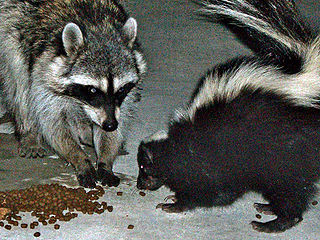
The Holocene extinction, or Anthropocene extinction, is the ongoing extinction event caused by humans during the Holocene epoch. These extinctions span numerous families of plants and animals, including mammals, birds, reptiles, amphibians, fish, and invertebrates, and affecting not just terrestrial species but also large sectors of marine life. With widespread degradation of biodiversity hotspots, such as coral reefs and rainforests, as well as other areas, the vast majority of these extinctions are thought to be undocumented, as the species are undiscovered at the time of their extinction, which goes unrecorded. The current rate of extinction of species is estimated at 100 to 1,000 times higher than natural background extinction rates and is increasing. During the past 100–200 years, biodiversity loss and species extinction have accelerated, to the point that most conservation biologists now believe that human activity has either produced a period of mass extinction, or is on the cusp of doing so. As such, after the "Big Five" mass extinctions, the Holocene extinction event has also been referred to as the sixth mass extinction or sixth extinction; given the recent recognition of the Capitanian mass extinction, the term seventh mass extinction has also been proposed for the Holocene extinction event.
Overconsumption describes a situation where a consumer overuses their available goods and services to where they can't, or don't want to, replenish or reuse them. In microeconomics, this may be described as the point where the marginal cost of a consumer is greater than their marginal utility. The term overconsumption is quite controversial in use and does not necessarily have a single unifying definition. When used to refer to natural resources to the point where the environment is negatively affected, it is synonymous with the term overexploitation. However, when used in the broader economic sense, overconsumption can refer to all types of goods and services, including manmade ones, e.g. "the overconsumption of alcohol can lead to alcohol poisoning". Overconsumption is driven by several factors of the current global economy, including forces like consumerism, planned obsolescence, economic materialism, and other unsustainable business models and can be contrasted with sustainable consumption.

A keystone species is a species that has a disproportionately large effect on its natural environment relative to its abundance, a concept introduced in 1969 by the zoologist Robert T. Paine. Keystone species play a critical role in maintaining the structure of an ecological community, affecting many other organisms in an ecosystem and helping to determine the types and numbers of various other species in the community. Without keystone species, the ecosystem would be dramatically different or cease to exist altogether. Some keystone species, such as the wolf, are also apex predators.
An ecological or environmental crisis occurs when changes to the environment of a species or population destabilizes its continued survival. Some of the important causes include:

An apex predator, also known as a top predator, is a predator at the top of a food chain, without natural predators of its own.
The "World Scientists' Warning to Humanity" was a document written in 1992 by Henry W. Kendall and signed by about 1,700 leading scientists. Twenty-five years later, in November 2017, 15,364 scientists signed "World Scientists' Warning to Humanity: A Second Notice" written by William J. Ripple and seven co-authors calling for, among other things, human population planning, and drastically diminishing per capita consumption of fossil fuels, meat, and other resources. The second notice has more scientist cosigners and formal supporters than any other journal article ever published.

An abrupt climate change occurs when the climate system is forced to transition at a rate that is determined by the climate system energy-balance. The transition rate is more rapid than the rate of change of the external forcing, though it may include sudden forcing events such as meteorite impacts. Abrupt climate change therefore is a variation beyond the variability of a climate. Past events include the end of the Carboniferous Rainforest Collapse, Younger Dryas, Dansgaard–Oeschger events, Heinrich events and possibly also the Paleocene–Eocene Thermal Maximum. The term is also used within the context of climate change to describe sudden climate change that is detectable over the time-scale of a human lifetime. Such a sudden climate change can be the result of feedback loops within the climate system or tipping points in the climate system.

Environmental vegetarianism is the practice of vegetarianism that is motivated by the desire to create a sustainable diet, which avoids the negative environmental impact of meat production. Livestock as a whole is estimated to be responsible for around 15% of global greenhouse gas emissions. As a result, significant reduction in meat consumption has been advocated by, among others, the Intergovernmental Panel on Climate Change in their 2019 special report and as part of the 2017 World Scientists' Warning to Humanity.
Human overpopulation describes a concern that human populations may become too large to be sustained by their environment or resources in the long term. The topic is usually discussed in the context of world population, though it may concern individual nations, regions, and cities.
Trophic cascades are powerful indirect interactions that can control entire ecosystems, occurring when a trophic level in a food web is suppressed. For example, a top-down cascade will occur if predators are effective enough in predation to reduce the abundance, or alter the behavior of their prey, thereby releasing the next lower trophic level from predation.

The mesopredator release hypothesis is an ecological theory used to describe the interrelated population dynamics between apex predators and mesopredators within an ecosystem, such that a collapsing population of the former results in dramatically increased populations of the latter. This hypothesis describes the phenomenon of trophic cascade in specific terrestrial communities.

Climate crisis is a term describing global warming and climate change, and their impacts. This term and the term climate emergency have been used to describe the threat of global warming to humanity and the planet, and to urge aggressive climate change mitigation and "transformational" adaptation. In the scientific journal BioScience, a January 2020 article, endorsed by over 11,000 scientists worldwide, stated that "the climate crisis has arrived" and that an "immense increase of scale in endeavors to conserve our biosphere is needed to avoid untold suffering due to the climate crisis."
Overpopulation or overabundance is a phenomenon in which a species' population becomes larger than the carrying capacity of its environment. This may be caused by increased birth rates, lowered mortality rates, reduced predation or large scale migration, leading to an overabundant species and other animals in the ecosystem competing for food, space, and resources. The animals in an overpopulated area may then be forced to migrate to areas not typically inhabited, or die off without access to necessary resources.

Environmental issues are disruptions in the usual function of ecosystems. Further, these issues can be caused by humans or they can be natural. These issues are considered serious when the ecosystem cannot recover in the present situation, and catastrophic if the ecosystem is projected to certainly collapse.

A Mesopredator is a predator that occupies a mid-ranking trophic level in a food web. There is no standard definition of a mesopredator, but mesopredators are usually medium-sized carnivorous or omnivorous animals, such as raccoons, foxes, or coyotes. They are often defined by contrast from apex predators or prey in a particular food web. Mesopredators typically prey on smaller animals.
Proforestation is the practice of protecting existing natural forests to foster continuous growth, carbon accumulation, and structural complexity. It is recognized as an important forest based strategy for addressing the global crises in climate and biodiversity. Forest restoration can be a strategy for climate change mitigation. Proforestation complements other forest-based solutions like afforestation, reforestation and improved forest management.

The ecology of fear is a conceptual framework describing the psychological impact that predator-induced stress experienced by animals has on populations and ecosystems. Within ecology, the impact of predators has been traditionally viewed as limited to the animals that they directly kill, while the ecology of fear advances evidence that predators may have a far more substantial impact on the individuals that they predate, reducing fecundity, survival and population sizes. To avoid being killed, animals that are preyed upon will employ anti-predator defenses which aid survival but may carry substantial costs.

The Glasgow Agreement is an international platform made up of various organisations which aim to coordinate themselves and use novel strategic tools in order to fight for climate justice.

Scenarios in which a global catastrophic risk creates harm have been widely discussed. Some sources of catastrophic risk are anthropogenic, such as global warming, environmental degradation, and nuclear war. Others are non-anthropogenic or natural, such as meteor impacts or supervolcanoes. The impact of these scenarios can vary widely, depending on the cause and the severity of the event, ranging from temporary economic disruption to human extinction. Many societal collapses have already happened throughout human history.
Phoebe Elizabeth Barnard is an American global change scientist and professor of conservation biology and environmental futures at the University of Washington. Barnard has written more than 180 publications on the vulnerability of biodiversity and ecosystems to climate and land use change. She is a member of several global initiatives including the Club of Rome's Planetary Emergency Partnership, one of five core co-authors of the 2020 paper World Scientists’ Warning of a Climate Emergency, lead author of the action-focused 2021 World Scientists' Warnings into Action: Local to Global, second of 11 co-authors of the 2023 World Scientists' Warning: the Behavioural Crisis Driving Ecological Overshoot, a provocative collaboration of scientists, educators and global marketing strategists, and major co-author of Earth at Risk: an Urgent Call to End the Age of Destruction and Forge a Just and Sustainable Future.











